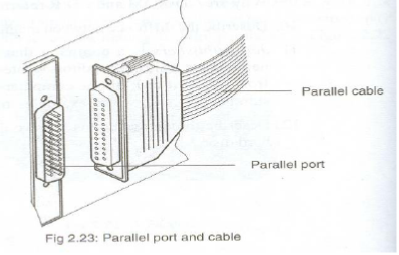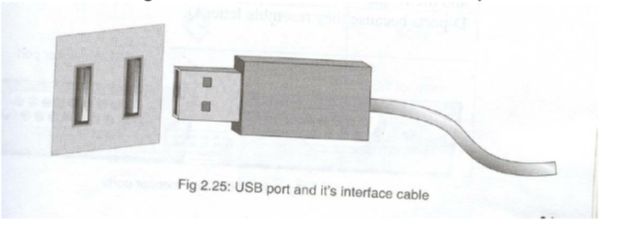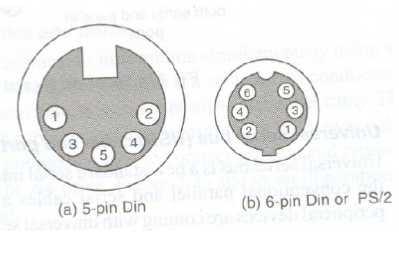Power cables
Inside the system unit is a special power supply unit that supplies power to the motherboard and other internal devices.In order to connect the computer to the mains power outlet,you need power cables that link the power supply unit to the outlet.
Interface cables
All peripheral devices are connected to the motherboard hence to the CPU by special cables called interface cables.An interface cable is connected to the device on one end,and to the motherboard via ports on the other end.The difference between the power cables and the interface cables is that the power cable supplies power to a component while interface cables transmit
data signals.
There are different types of cables and parts namely;
Parallel cables and ports
Parallel cables transmit information simultaneously using a set of many conductors(wires).For example if a cable uses 8 conductors to transmit data at the same time,it is said to be an 8-bit parallel cable.The advantage of using such cables is that they transmit data faster over a short distance.These cables are mostly used to connect printers and removable storage drives like the zip drive.The figure below shows an illustration of a parallel port and cable.

Serial cables and ports
Unlike the parallel cables,serial cables transmit one bit at a time. Although they are slow, they are much more reliable than the parallel ports and therefore,their connector cables can be as long as 15 m. Serial cables are
generally used to connect devices such as the mouse and some serial printers.
Figure below shows a 9 and a 25 pin serial ports.

Universal serial bus(USS) cable and port
Universal serial bus is a new standard serial interface that is set to replace the conventional parallel and serial cables and ports.Currently most peripheral devices are coming with universal serial bus ports and interface cable.Although it transmits only 1-bit at a time,it provides very high-speed and quality data transmission over distances of approximately 5 metres. USB supports a wide range of peripheral devices ranging from external storage drives to digital cameras. Figure below shows a USB port and its interface cable.

If a computer does not have a universal serial bus port,it can be bought and fitted on the motherboard.
Small computer systems interface(SCSI)cables and port
This port and interface cables transmit data in parallel but are faster than the parallel cables.Another advantage of the SCSI port is that one SCSI port allows us to connect upto eight peripheral devices
Other ports and connectors .Other ports and connectors include;
5-pin DIN and 6-pin(PS/2)ports.Originally,most computers used the 5-pin DIN to connect a keyboard to the system unit but the smaller 6-pin mini-DIN also known as PS/2 interface port has almost replaced this technology.Currently most computers come with the PS/2 connector as the new standard to connect PS/2 mouse and keyboard.The figures below shows a 5-pin and PS/2 connectors showing physical difference in size.

Monitor ports
The two most common connectors used for monitors are the 9-Pin D and the 15-pin D connector as shown.They are called D ports because they resemble letter D.

Audio connectors
These are jack plugs found on a sound interface adapter used to connect speakers,microphone and other portable audio equipment

